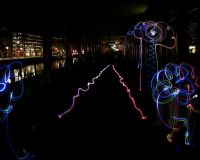Posted on Sun 3 Oct 2021
Trauma Informed Equitable Futures
Grace Quantock shares her thinking on envisioning a trauma informed future.

Posted by
Project

Towards Equitable Futures (2020)
We live in capitalism, its power can often seem inescapable - but then, so did the divine right of kings. Any human power can be resisted and changed by human beings. Resistance and change often begin in art. Ursula K. Le Guin, National Book Foundation Medal speech 2014 Towards Equitable…If you have been following our Towards Equitable Futures blog posts you may remember that our first workshop with the Future Visioning Group included a session on trauma informed working with Grace Quantock (who worked alongside the Design Team in the early stages of the project). Grace is a therapist, writer and researcher. She specialises in working with people with multiple marginalised and minoritised identities and trauma. Grace’s work is embedded in the collection, processing, understanding and sharing of context, story and understanding of self and place. Sign up for her monthly trauma informed essays Postcards From The Margins and follow her on Twitter. The piece below is written by Grace, as and when the time was right, and shared by me with love and thanks.
I plant heritage seeds in my garden. These are old seeds, handed down in families and communities. These seeds aren’t like the ones that work for commercial farms where everything matures at the same time, giving a crop that stores well and transports to supermarkets without damage. No, the heritage seeds are eccentric, tasty and nutritious.
But they need to be tended, you can’t buy them in the shops. Once the crop is grown, part of it is left to go to seed; dried pea pods, seeds pods from kale and so on. These are collected, dried and stored. They arrive at my house in envelopes, often with their names—Deer Tongue Lettuce, Bronze Arrow Lettuce, Llanover Pea—scrawled on the envelope by the last seed guardian, as the people who grow, save and share the seeds are called.
I was taught I can’t simply poke these seeds in the ground and hope for the best. They’ve been stored, sometimes for years, in a cold shed or the back of a fridge. I wake them up. Using damp paper towels, sunlight and gently increasing temperatures, I tell the seeds: it's different now, you aren’t in the dark anymore. There wasn’t light or water before, but now there is. We’ve made things different here. Can we grow?
In envisioning a trauma informed future, I think we do something similar. Not only being aware of our own trauma as we build but aware of the trauma in the communities we are building for. Working towards a day when we can check-in and ask, “Is this environment different? Can I do something different today?”
I believe trauma informed working and acknowledging what shaped us into today is a part of making that future come into being.
It is possible to imagine a future without considering the impact of trauma. We can dismiss the presence and shaping of trauma, but in doing so, we are invisiblising the experiences and realities that shape our internal and external worlds. Trauma is perpetuated and created through intentional and active methods.
A common way of re-creating trauma is denying its presence or impact. In exploring equitable futures, it is necessary to explore trauma informed futures because trauma follows lines of inequity and oppression. Ignoring it is missing the wounds and legacies of systems. A great deal of trauma work is based on making the invisible trauma known and explicit. When we can see what shapes our lives and sensations, we can work with it more clearly. That’s the insight we brought to equitable futures; equity is informed by awareness in the possibilities we create.
But trauma is tricky. It’s tricky to live with because it’s present and hidden, slippery and invisible. Painful. But it's also tricky in that the word has become relatively normalised. We can be uncertain as to what each of us mean when we say trauma.
When I talk about trauma, I'm talking about two things:
1) The traumatic event, experience, series of events, part of a life or that which people survived.
2) The symptoms, fallout or repercussions of those situations or experiences, that live on in us.
Our image of trauma is often of a concrete, single, (if painful) incident. Like a car accident, or a single experience of violence. It can be those things, but often trauma is not that delineated.
Often we will say to ourselves, ‘this doesn't count’ about our trauma. We imagine a kind of story book trauma, in which everything was clear cut. But the boundaries we draw around trauma can be complex. When people inquire if we’re a trauma survivor, in my experience, they're looking for a concrete story with a clear narrative. Trauma doesn't have clear narratives.
In addition to this, the fallout and impacts of trauma can be much more diffuse than may be imagined and can be very confusing, even to survivors of trauma. Of course, all of this feels terrible. Who wants to pay close attention to what feels so awful? In my practice, I differentiate between trauma response and activation.
If somebody says something to me that is upsetting or distressing, I may become activated. I may find my breathing comes shorter, or I start to perspire, my thoughts begin rushing. This can happen if there's a trauma response, too. But it can also happen just because something's difficult, upsetting or distressing. It doesn't have to be linked to any trauma that I survived.
A trauma trigger is when a past trauma gets activated. We may not know there’s a past trauma there—we're not necessarily sitting thinking, “Aha, that is a trigger from the 2007 traumas”. Because it's not necessarily as clear as that. But a trigger is when something in our past is triggered, and it comes up in us. It's a past thing coming into our present. Or a past thing that’s pulling us back into the past.
You may have heard of flashbacks, these can be visual; when we actually see ourselves back somewhere. There are also auditory flashbacks, where you hear things from the past. You can have emotional flashbacks. Which would be where you're in Aldi, say and you're shopping, it’s fine. Then perhaps somebody walks past you wearing a scent that is a trigger for you. Suddenly, you desperately want to hide under the freezers and you don't know why. You're feeling emotionally like you did in another, painful, time. In this space, it can feel like all of the work you've done on yourself, or in therapy or in community, all that's gone because you're back to where you were in that painful moment. That's one of the trickiest things, because you can feel like you've lost all your ground and like you don't know who you are anymore.
Some people also get what are called intrusive thoughts or images. You might be working or in bed, and an intrusive thought or image just comes into your mind. You’re in the present, but you just can't seem to stop these images or thoughts bubbling up. They keep intruding.
If we are struggling with these states, or people in our community are, then we may find people are using various ways to try and cope. Some might be ones we find easy and acceptable, some might be difficult or something many people judge. In gestalt therapy, we call these creative adjustments. Creative ways of using what’s available in your environment to try and cope with what’s painful or unbearable.
Perhaps they're not the best but people used what was available at the time. In looking to make change, it can be useful to check in, is there something else available to us now, that we can use instead?
Because humans are often not great at updating to our current circumstances. We stay in our patterns for long periods.
So we may find we zone out when we experience distress and activation. Maybe we come back to ourselves hours later, realising we haven’t eaten or taken a break or had any water. Perhaps we zone out by scrolling on social media, but we get full up on further traumatising material during this process.
There may be pressure to ‘ground’, to be present and mindful with the pain. But sometimes that is more than we can bear. We might check in on how we can get space from the pain more safely than zoning out completely. Perhaps a favourite video game provides distraction, but within a familiar, supportive setting? It might be a film with a friend or a favourite old podcast offer distraction without adding additional difficult material. Can we have some supplies to hand so we have snack, drink and screen breaks between episodes? It’s not about pulling ourselves away from what is needed but exploring ways to manage that are easier for us. All this is, of course, happening against a wider background of needed social and cultural change.
Trauma can also be too big; the trauma of a place, a community, an experience can be too great for visioning of the future to happen then. Trauma is sticky, intense and leaves a long shadow that stretches beyond what we might imagine. I believe in respecting the process and experience in those times, there is other work here; repair, restoration, seeking justice. These conversations can happen alongside seeking a new future, but the safety of the people involved is paramount. Without sufficient safety, we can’t vision fully. Without inclusion, we can’t envision a true future.
Equitable Futures is planting seeds, we hope to grow and tend them into the needed, resourced futures we need.
